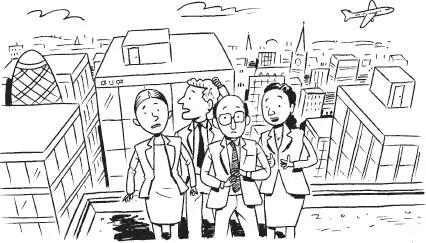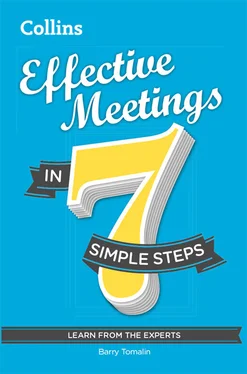PREPARE USEFUL DOCUMENTS
‘Whoever controls the minutes, controls the meeting!’ — UK finance manager
Always have an agenda.
Communicate the aim and objectives.
Organise the discussion documents for the meeting.
Know how to present your own ideas.
Take and present minutes to suit the meeting.
Assume the meeting can run by itself.
Waste time by not organising/attaching discussion papers.
Fail to ask someone to take the minutes.
Write down what everyone says and then try to reproduce it.
Forget to check minutes before circulation.
Good meetings depend on planning and successful planning depends partly on good documentation.
Four key documents will contribute to a successful meeting. They are:
The invitation
The agenda
Supporting papers and discussion documents
The minutes
The invitation makes sure you get the right people in the right place on the right day at the right time.
The agenda is your roadmap to success. It is the path to meeting the goals and objectives of your meeting. It ensures you clarify your meeting objectives and it identifies the process you need to go through to achieve them with the relevant stakeholders.
The supporting papers and discussion documents provide the necessary background to any discussion, but need to be presented in an unambiguous and accessible way.
The minutes are not just a record of the meeting. They are an action plan going forward.
Clear, relevant and action-oriented action points provide the platform for the next steps.
There should be a clear progression from the agenda to the minutes. The order of the minutes should reflect the order of the agenda and should clearly relate to the subject headings and issues raised in each item. If it doesn’t, you risk confusion.
When you prepare an invitation, you tell attendees about the meeting: where they need to go, what date and what time.
Sounding pro: Meeting invitations
Here’s an example of an invitation:
To:
From:
Re: Team meeting
Dear Colleagues ,
We are holding two meetings in May to discuss reorganisation of the department. It is extremely important that everyone in the team attends. We are proposing two dates: May 17 thor May 24 that 1 p.m. in the canteen. Please let me know by May 6 thwhich date or dates you are available for.
I look forward to hearing from you. Thank you.
Sara Leboeuf
HR Manager
Why is this invitation successful?
It’s clear – it states the type of meeting.
It explains – it doesn’t take for granted that the participants know.
It specifies attendance – it says who should come.
It offers alternative time slots.
It offers a choice of dates.
It’s polite and it makes clear requests with a clear deadline.
It shows authority – the sender states her job title at the end.
The invitation also creates a record. Do people need a record? If you’ve got back-to-back meetings or very few meetings, yes, you do. Knowing where you have to be and when is all important.
Date
Write it how you like. Some people prefer May 6th 2013 . Some like 6th May 2013 . Many people, even in the UK, use the US form 6 May 2013 or May 6 2013 .
You may see this: 6/7/13 (the 6 thof July 2013), but be careful, as in America and other parts of the world, the month comes first, like this: 7/6/13 (the 6 thof July 2013) not, as it looks to the British (the 7 thof June 2013).
If in doubt, copy the format from a previous meeting.
Time
Just to be clear, many companies now use the 24-hour clock and write the time as part of a 24-hour period. So 09:05 is five minutes past nine a.m. and 12:05 is five minutes past 12 o’clock midday. Alternatively, you can use a.m./p.m.
It’s important to note that people from different cultures have different attitudes to time. Some are much more tolerant of delays and lateness than others. The UK, by and large, is an ‘on time’ culture. It’s much better to arrive five minutes early for a meeting than five minutes late. Also, if you’re going to be late you should ring and advise as early as possible.
Location
This is straightforward: building, address (if needed) and room number, e.g.
Room 101 Edinburgh Building 3 East Side Nottingham
Be careful you get numbers and addresses right. If the meeting is in your office building, check the room booked corresponds to the room number on the invitation and agenda.
If the meeting is off-site (i.e. away from the office), check the directions (they are sometimes called joining instructions) are easy to follow. Do get it right. It’s all too easy to send people to the wrong room or even to the wrong building on the wrong side of town!
Check and double-check the details are right. If you’re in the same building, nip along and check. Fifteen minutes spent now might save hours of wasted time and frustration later – for you and the participants. After all, you don’t want to end up on the roof!

Requesting items for inclusion
Sometimes the invitation may include a request for items to be discussed by the participants. Imagine this situation. You had an action point from the last meeting that you haven’t been able to complete. So you want to have further discussion in the next meeting. The best way to do this may be to put it on the agenda for the meeting.
It’s worth asking all participants if they want to include this or perhaps another item. You can either do this when you send out the invitation or else in a separate email, once the meeting date has been agreed.
Date: All addressees: Subject: Agenda items for meeting on 28 thMarch
Dear all, Please let me have any agenda items for the meeting on 28 thMarch by 5 p.m. on 25 thMarch.
Thank you very much. Tom Hadfield
Before we go on to the next piece of documentation, the agenda, let’s make a distinction between two types of meeting. The first is the regular meeting. This is a meeting of a project team or department which takes place at regular intervals, weekly or monthly. The aim of the meeting is primarily to update on progress and troubleshoot problems. This is the kind of meeting where the meeting leader may request items for inclusion, as above.
The second is a ‘one-off’ meeting to discuss a particular topic or issue. In this case, there has been no ‘last meeting’ and therefore it’s unlikely, though not impossible, that the meeting leader will request items for inclusion.
Agendas are the single organising principle of a business meeting. They define what needs to be discussed and in what order. They are therefore the starting point for any successful meeting, and the lack of one is the main starting point for an unsuccessful meeting. But they also have another function. They help you organise your thoughts. When you write an agenda, automatically you think about what you want to agree on. These are the aims and objectives of the meeting.
Читать дальше













